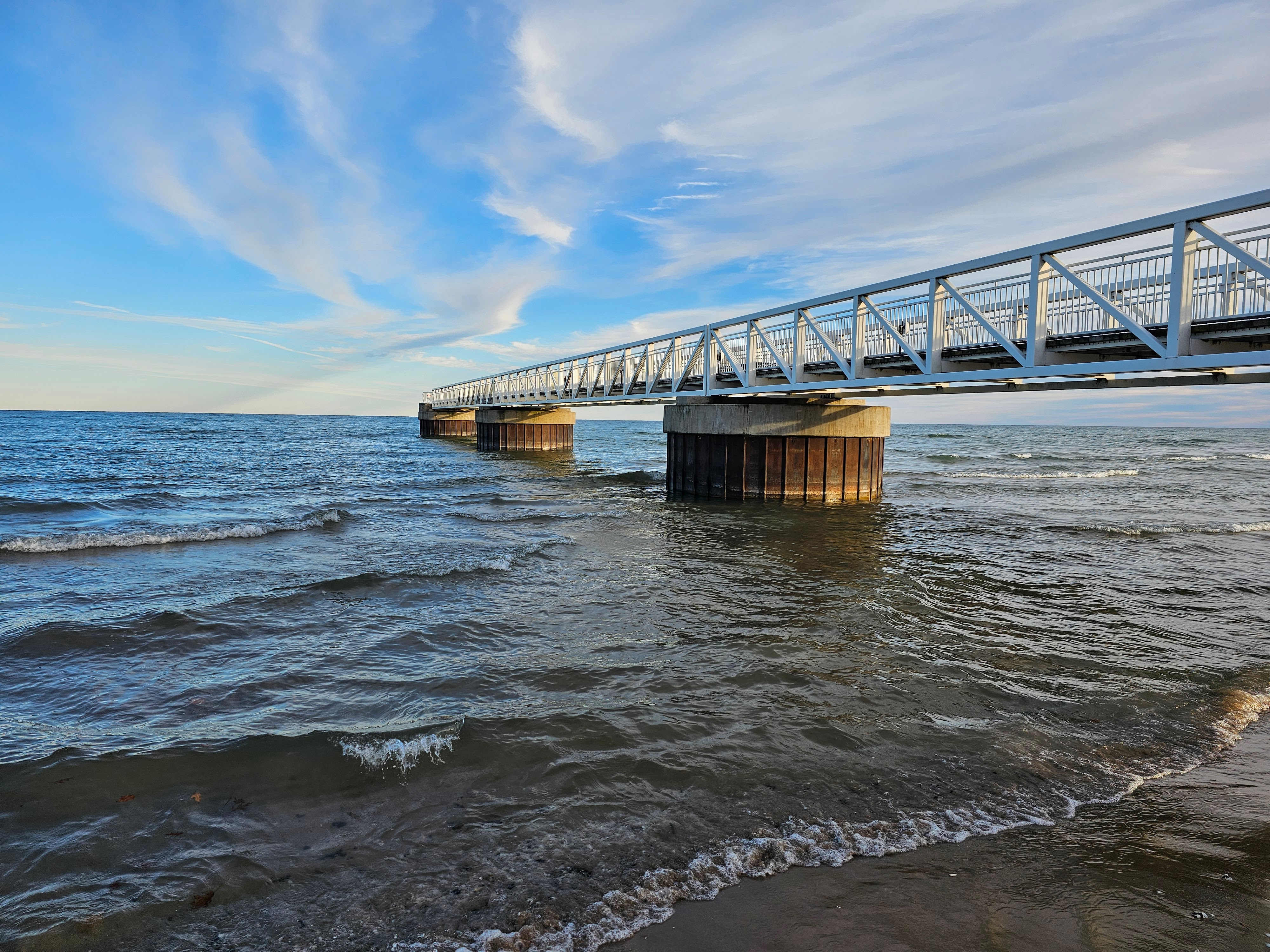
December is just around the corner, and many residents of the Great Lakes region have questions surrounding water levels on the lakes and the upcoming winter season. Here are some common questions about lake levels, water temperatures, winter outlooks, and ice cover, answered by a team of NOAA GLERL scientists.
Why are Great Lakes water levels going down right now?
Great Lakes water levels undergo a relatively consistent seasonal pattern year after year, with lower levels in the winter and higher levels in the summer. During the winter, precipitation falls as snow and accumulates on land. In the spring, increased precipitation and melting snow add water to the lakes, causing a rise in water levels. Peak levels occur in summer to early fall. In the fall, cooler and drier air flows over the warmer lake waters. This contrast in temperature and moisture between the air and water helps to increase the evaporation from the water. The graphic below illustrates the seasonal cycles that Great Lakes water levels go through every year.
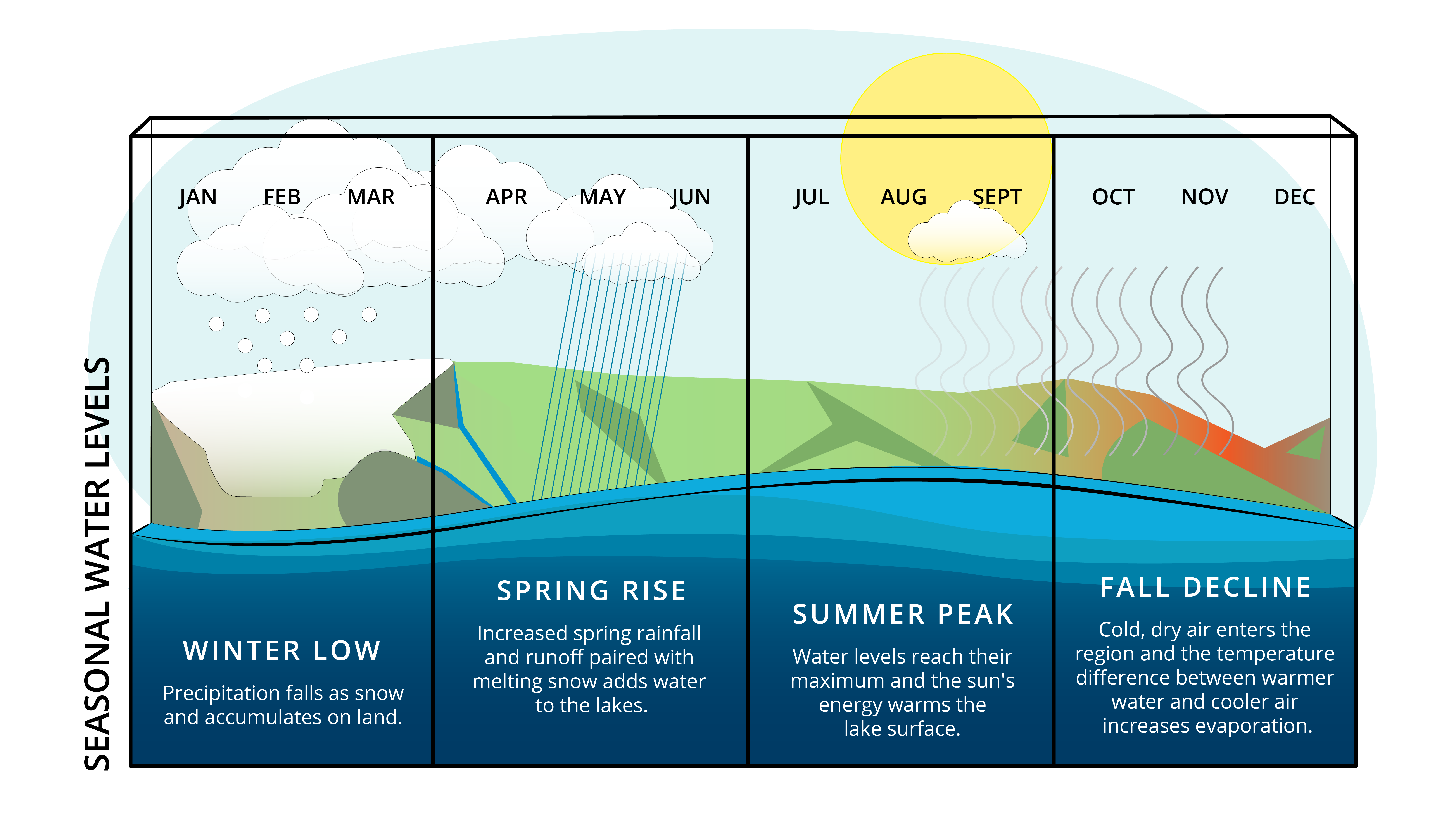
Why are lake levels falling below their long-term average this year?
In addition to their regular fall decline, some of the Great Lakes—notably Lake Superior and Lake Michigan-Huron—are experiencing water levels that are slightly below their long-term average for this time of year. (Note that because they are connected by the Straits of Mackinac, Lakes Michigan and Huron are actually considered one lake when it comes to hydrology!)
“It is noteworthy that this year is the first time since 2014 that we’ve seen the monthly mean on Lake Michigan-Huron being slightly below the long-term average,” says Dr. Lauren Fry, NOAA GLERL Physical Scientist. “The drivers of water levels are the precipitation over the lakes, the runoff into the lakes, and the evaporation from the lakes. It’s a combination of those influences that drive how the water levels change on a seasonal, annual, and interannual basis. Over the past few months we’ve seen below-average precipitation, which is contributing to the slightly below average levels we’re seeing this fall.”
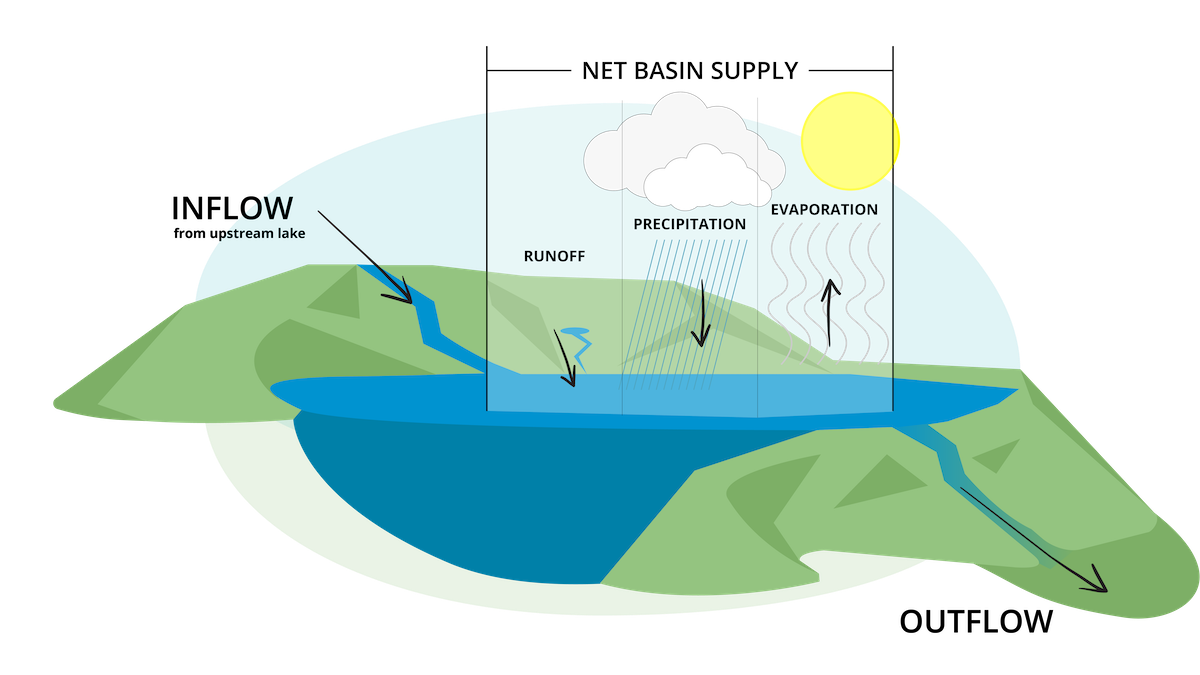
Dr. Fry also notes that warmer temperatures in October were a contributing factor, as this helped keep lake temperatures warm, ultimately enhancing the evaporation we’re seeing from the lakes.
Is this change normal?
In addition to fluctuating seasonally, Great Lakes water levels fluctuate between high and low periods on a multi-year timescale. The lakes have been experiencing above-average water levels since 2014, culminating in record high water levels occurring between 2017-2020, depending on the lake. This transition period highlights the need to be prepared for variability between multi-year periods of high levels and low levels in the future.
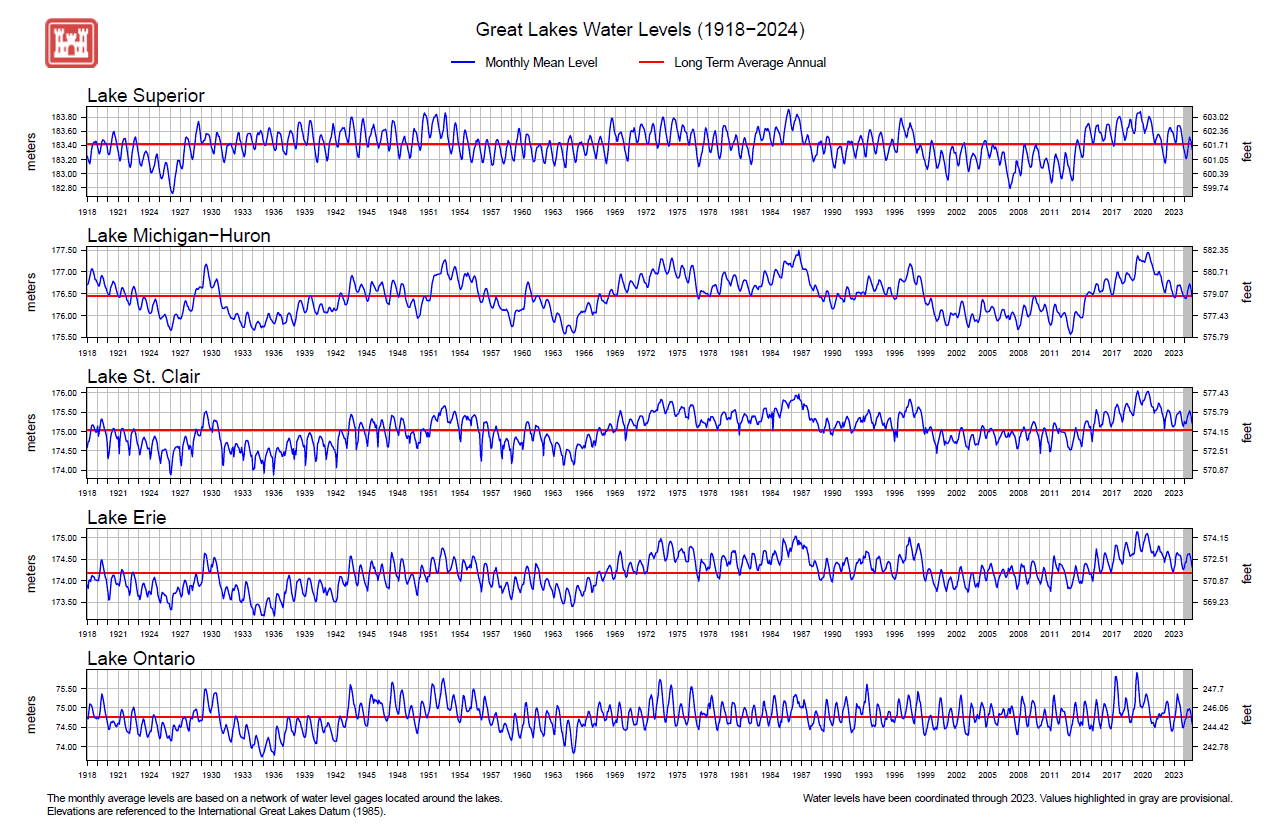
What are the impacts of lower lake levels?
During periods of low water, lake access can become an issue. Docks can be higher than they’re supposed to be, making it more difficult to board a boat from its dock. Conversely, those with lower docks may benefit from the lower levels.
With more land exposed during low water periods, vegetation has more space to spread out and grow along the shoreline. This can be beneficial for coastal wetland ecosystems, but can potentially make recreational areas harder to access.
The commercial shipping industry can also be impacted by low water levels, as crucial shipping areas become shallower when the water is low. Vessels may be able to carry less cargo weight as a result, and may even need to avoid particularly shallow areas altogether.
On the plus side, we can expect to see less erosion during periods of low water levels compared to erosion when water levels are high.
Learn more about water level impacts from the International Joint Commission.
Are lake temperatures warmer than average?
Year-to-date temperatures
Lakes Michigan, Huron, Erie and Ontario have all experienced record high year-to-date (YTD) average surface temperatures in 2024 so far, compared to NOAA GLERL’s 30-year satellite record. This is partially due to the warm fall we’re experiencing now, but also due to the notably warm 2023-2024 winter.
While the Great Lakes region has definitely had a warm fall, it’s not as extreme as the preceding warm winter. The combination of the two warmer-than-average seasons have led to a record warm year-to-date average for all lakes except Superior.

For the four lakes that are currently at record high YTD averages, their previous record highs all occurred in 2012. Each lake’s previous 2012 record (°F) is listed below.
Michigan: 53.3
Huron: 51.5
Erie: 56.2
Ontario: 54.8
Lake Superior’s existing record high YTD average of 47.9°F occurred in 2012 as well.
It is important to keep in mind that water temperatures vary day to day. Although four of the lakes have record warm YTD average temperatures, more than half of the days this fall have not broken their records for daily lake temperatures.
Current lake temperatures
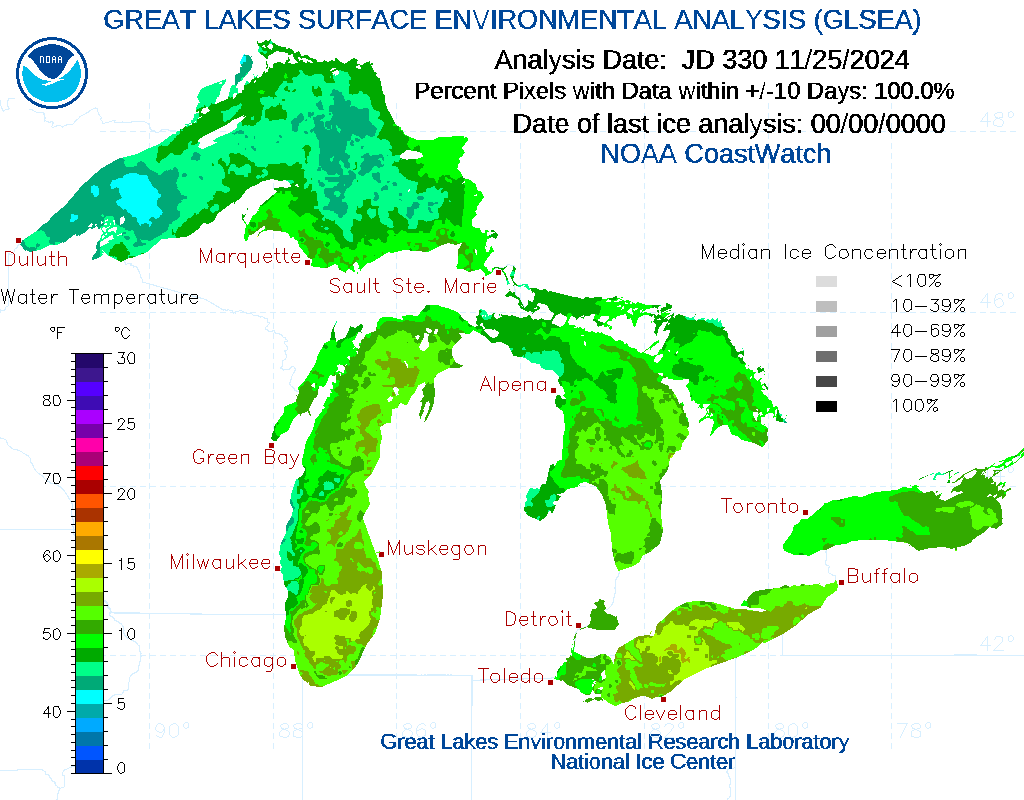
Right now, Great Lakes surface temperatures are running about 4-7 degrees Fahrenheit above the long-term average for this time of year. This is predominantly due to the warmer-than-average weather we’ve been experiencing throughout the region this fall.
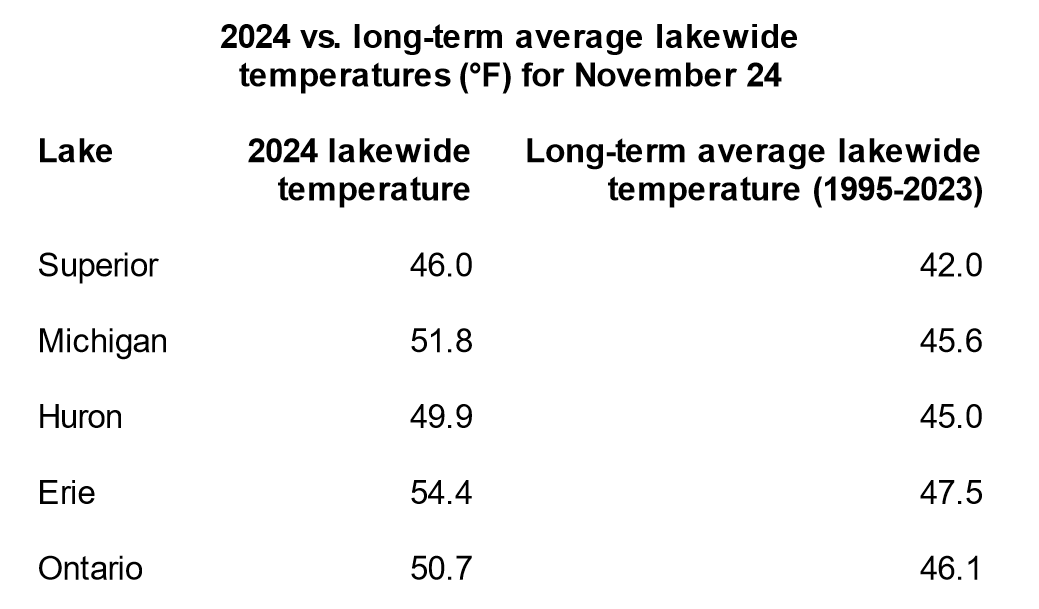
Beginning on Thanksgiving day, and lasting through the first week of December, the first arctic airmass of the season descended upon the Great Lakes region. Below normal air temperatures and locally significant amounts of lake effect snow were common, resulting in a slow decrease in the observed surface water temperatures. Despite the lengthy period of colder weather, lake surface temperatures are expected to remain above average as we head into the middle portion of December.
Why do lake temperature records only date back to 1995?
The mid 1990s is when we first had reliable satellite data with which to construct more accurate and complete datasets for lakewide surface temperatures. Before this, the ability to measure lake surface temperatures was limited to specific locations, and lakewide measurements were not possible. This is why we only use the 30-year dataset for our calculations, as this represents the highest quality data.
What kind of winter is expected for the Great Lakes this year?
While it’s too soon to say for sure how this winter will pan out, here are some key takeaways for the Great Lakes region from NOAA’s official U.S. Winter Outlook:
Temperatures
The eastern Great Lakes region may experience warmer than normal temperatures from December through February, with equal chances for above- or below- average temperatures across the western part of the region. The warmest temperatures may be skewed toward the early winter, with the entire month of December appearing as if it will be quite above normal for most of the lakes. As we head deeper into the winter, we could potentially see cooler than normal temperatures across parts of the northern and western Great Lakes basin.
Precipitation
The December through February period is expected to present above-average precipitation across the majority of the Great Lakes basin, with the wettest conditions occurring during the second half of the winter season.
“The main driver of the winter forecast is the onset of La Niña conditions in the equatorial Pacific late this fall and into the winter season,” says Bryan Mroczka, NOAA GLERL Physical Scientist. “La Niña typically results in a more northerly storm track across the continental U.S., bringing enhanced chances for precipitation to our region as the pattern grows and matures.”
Will Great Lakes ice cover be low again this year?
Last year’s record-low ice cover on the Great Lakes was largely due to significantly warmer winter air temperatures throughout the region. The warmer-than-normal air temperatures predicted for the upcoming winter may set us up for another slow start to the ice season, but for now, it’s too soon to make any concrete predictions.
Why is ice cover important?
Great Lakes communities have strong economic ties to ice cover on the lakes, and changes in ice cover can have big impacts on the people living there. Many local businesses in the area rely on ice fishing and outdoor sports, which can only happen if the ice is thick and solid. Some fish species also use the ice for protection from predators during spawning season, and there’s increasing evidence that the ice plays a role in regulating many biological processes in the water throughout the winter. Commercial shipping schedules are heavily impacted by the formation of ice as well.
Additional Resources
NOAA Great Lakes CoastWatch (water temperature and ice data)

Pingback: NOAA GLERL prepares for 2025 ice season | NOAA Great Lakes Environmental Research Laboratory